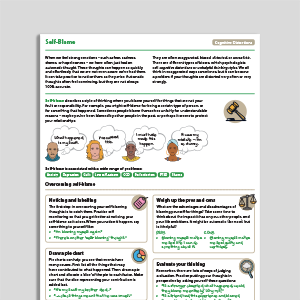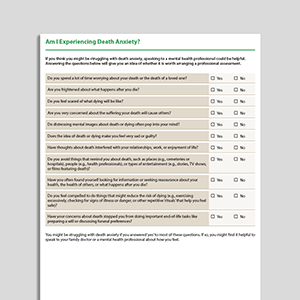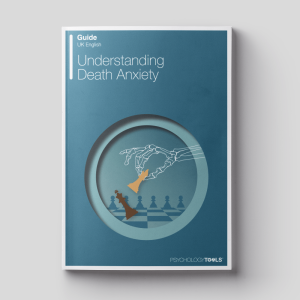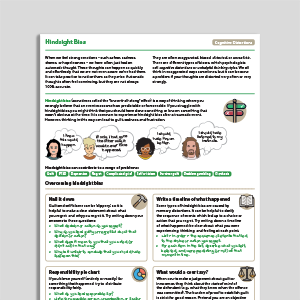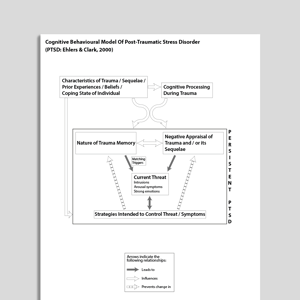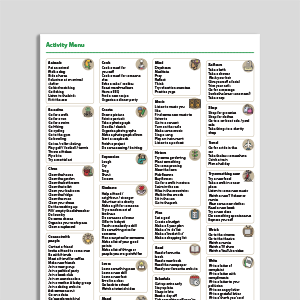Grief, Loss & Bereavement
Loss and grief are universal processes and people ordinarily have the natural capacity to adjust to their new lives in the absence of loved ones. However, some losses are experienced more profoundly than others—they cause greater or more prolonged grieving and such reactions are sometimes described as ‘complicated’ or ‘complex.’ This can be associated with characteristics of the loss, or with the meaning of the loss for the individual concerned.
Showing 1 to 18 of 18 results
What Keeps Death Anxiety Going?
What Keeps Death Anxiety Going?
Am I Experiencing Death Anxiety?
Am I Experiencing Death Anxiety?
Understanding Death Anxiety
Understanding Death Anxiety
Exposures For Fear Of Death
Exposures For Fear Of Death
Audio Collection: Psychology Tools For Developing Self-Compassion
Audio Collection: Psychology Tools For Developing Self-Compassion
Recognizing Prolonged Grief Disorder
Recognizing Prolonged Grief Disorder
Everyday 'Unusual' Experiences
Everyday 'Unusual' Experiences
Cognitive Behavioral Model Of Post Traumatic Stress Disorder (PTSD: Ehlers & Clark, 2000)
Cognitive Behavioral Model Of Post Traumatic Stress Disorder (PTSD: Ehlers & Clark, 2000)
Before I Blame Myself And Feel Guilty
Before I Blame Myself And Feel Guilty
Links to external resources
Psychology Tools makes every effort to check external links and review their content. However, we are not responsible for the quality or content of external links and cannot guarantee that these links will work all of the time.
Assessment
-
Perinatal Grief Scale (Short Version)
| Potvin, L., Lasker, J., & Toedter, L. | 1989
- Paper
-
Inventory of Complicated Grief
| Prigerson, H. G., Maciejewski, P. K., Reynolds, C. F., Bierhals, A. J., Newsom, J. T., Fasiczka, A., … & Miller, M. | 1995
- Paper
- Reference Prigerson, H. G., Maciejewski, P. K., Reynolds, C. F., Bierhals, A. J., Newsom, J. T., Fasiczka, A., … & Miller, M. (1995). Inventory of Complicated Grief: a scale to measure maladaptive symptoms of loss.Psychiatry research,59(1), 65-79
Guides and workbooks
- Remembering for good: wholehearted living after loss | Cath Duncan
-
Coping with trauma and loss
| Cruse bereavement care
- Coping with trauma and loss (Original leaflet)
- Coping with trauma and loss (Updated leaflet)
- Has Someone Died? Restoring hope | Cruse Bereavement Care
- Your grief: You’re not going crazy | MADD.org
- Bereavement – a self-help guide
Information Handouts
- Common reactions to grief and loss | NDARC
Information (Professional)
- Solution-focused interventions for prolonged grief | Macdonald
- Helping children to cope with death | MADD.org
Presentations
- Supporting the bereaved: theory and practice | Dent | 2005
- Using Acceptance and Commitment Therapy to negotiate losses and life transitions | Speedlin, Milligan, Haberstroh, Duffey
- ACT and grief | Russ Harris
- Complicated grief treatment: the theory, practice and outcomes | Dr M. Katherine Shear
- Bereavement and loss | Barbara McKay
- Grief and bereavement: a practical approach | Ian Anderson
- Attachment, loss, and complicated grief | Dr M. Katherine Shear | 2011
Treatment Guide
- Supporting children through grief | Cruse Bereavement Care
- When someone you know has died… – a guide for professionals offering bereavement support | Sue Read | 2014
Recommended Reading
- Wong, P. T. P. (2008). Transformation of grief through meaning: Meaning-centered counseling for bereavement. In A. Tomer, G. T. Eliason, & P. T. P. Wong (Eds.), Existential and spiritual issues in death attitudes (pp. 375-396). New York, NY: Lawrence Erlbaum Associates.
- Solomon, R. M., & Rando, T. A. (2007). Utilization of EMDR in the treatment of grief and mourning.Journal of EMDR Practice and research,1(2), 109-117.
- Stroebe, M., & Schut, H. (2010). The dual process model of coping with bereavement: A decade on. OMEGA-Journal of Death and Dying, 61(4), 273-289.
- Shear, K., Monk, T., Houck, P. et al. (2007). An attachment based model of complicated grief including the role of avoidance
- Shear, M. K. (2015). Complicated grief. N Engl J Med, 2015(372), 153-160
- Sabar, S. (2000). Bereavement, grief, and mourning: A gestalt perspective. Gestalt Review, 4(2), 152-168
- Rosner, R., Pfoh, G., & Kotoučová, M. (2011). Treatment of complicated grief. European Journal of Psychotraumatology, 2.
- An analysis of the concept of ‘chronic sorrow’. Olshanksy coined the term in the 1960’s to describe what he saw as the sense of loss some parents of disabled children have. The term has been expanded to encompass the loss that some people experience when faced with life-limited or option-limiting conditions
- Malkinson, R. (2010). Cognitive-behavioral grief therapy: The ABC model of rational-emotive behaviour therapy. Psychological Topics, 19 (2), 289-305
- Clark, A. (2004). Working with grieving adults. Advances in Psychiatric Treatment, 10, 164-170
- Boelen, P. A., Van Den Hout, M. A., Van Den Bout, J. (2006). A cognitive behavioral conceptualization of complicated grief. Clinical Psychology: Science And Practice, 13(2), 109-128link
What Are Grief, Loss, And Bereavement?
Signs and Symptoms of Grief, Loss, and Bereavement
People respond to loss in an enormous variety of ways. Emotional and behavioral responses to loss might include: sadness, preoccupation, yearning, depression, anxiety, or numbness. A grieving patient might oscillate between strong feelings and no feelings. Diagnostic systems are beginning to draw distinctions between normal and ‘pathological’ grief. DSM-5 identified persistent complex bereavement disorder, previously referred to as complicated grief, as a diagnostic category for further research.Signs and symptoms of persistent complex bereavement disorder are listed below. To meet diagnostic criteria for persistent complex bereavement disorder particular symptoms must have been present: to a clinically significant degree; on more days than not; in a manner which is out of proportion to or inconsistent with cultural, religious, or age-appropriate norms; and must have persisted for at least 12 months following the death:persistent yearning or longing for the deceased
intense sorrow and emotion pain in response to the death
preoccupation with the deceased
preoccupation with the circumstances of the death
marked difficulty accepting the death
experiencing disbelief or emotional numbness over the loss
difficulty with positive reminiscing about the deceased
bitterness or anger related to the loss
maladaptive appraisals about oneself in relation to the deceased or death (e.g., self-blame)
excessive avoidance of reminders of the loss
a desire to die in order to be with the deceased
difficulty trusting other individuals since the death
feeling that life is meaningless or empty without the deceased, or the belief that one cannot function without the deceased
confusion about one’s role in life, or a diminished sense of one’s identity
difficulty or reluctance to pursue interests since the loss or to plan for the future
Psychological Models and Theory of Grief, Loss, and Bereavement
There are a wide range of models and metaphors to help clinicians and their patients to conceptualize the grief process. A number of models draw upon Bowlby’s attachment theory to understand grief as a rupture in the attachment relationship.Elizabeth Kübler-Ross published a stage model of grief in her 1969 book On Death and Dying. Originally designed to understand emotional states experienced by terminally ill patients, it has been used more widely. It postulates that grieving individuals may go through stages of denial, anger, bargaining, depression, and acceptance.
Margaret Stroebe and Henk Schut published their dual-process model of coping with bereavement in 1999. They propose that effective ways of coping with bereavement include both loss-oriented and restoration-oriented process, and that bereaved individuals will oscillate between both processes.
Paul Boelen, Marcel van den Hout, and Jan van den Bout published a cognitive behavioral model of complicated grief in 2006. Bearing some similarities to the cognitive model of PTSD, this model identifies mechanisms that may serve to maintain and prolong the grieving process. These maintenance mechanisms include poor integration of the separation (loss) with existing autobiographical knowledge, negative global beliefs and misinterpretations of grief reactions, and anxious and depressive avoidance strategies.
Evidence-Based Approaches for Working with Grief, Loss, and Bereavement
Techniques that specialists in grief therapy have found helpful when working with grieving patients include:encouraging the patient to narrate their story of the loss, the events leading up to it, and subsequent events;
exploring the meaning of the loss for that individual;
engaging in mourning tasks;
using imagery to ‘talk’ to the deceased.
Resources for Working with Grief, Loss, and Bereavement
Psychology Tools resources available for working therapeutically with grief, loss, and bereavement may include:psychological models of grief, loss, and bereavement
information handouts for grief, loss, and bereavement
exercises for grief, loss, and bereavement including mourning tasks
grief and loss worksheets: CBT worksheets for grief, loss, and bereavement
self-help programs for grief, loss, and bereavement
References
Boelen, P. A., van den Hout, M. A., & van den Bout, J. (2006). A cognitive-behavioral conceptualization of complicated grief. Clinical Psychology: Science and Practice, 13(2), 109–128.
Kübler-Ross, E. (1969). On death and dying: What the dying have to teach doctors, nurses, clergy and their own families. New York: Scribner.
Stroebe, M., & Schut, H. (1999). The dual process model of coping with bereavement: Rationale and description. Death Studies, 23(3), 197–224.





